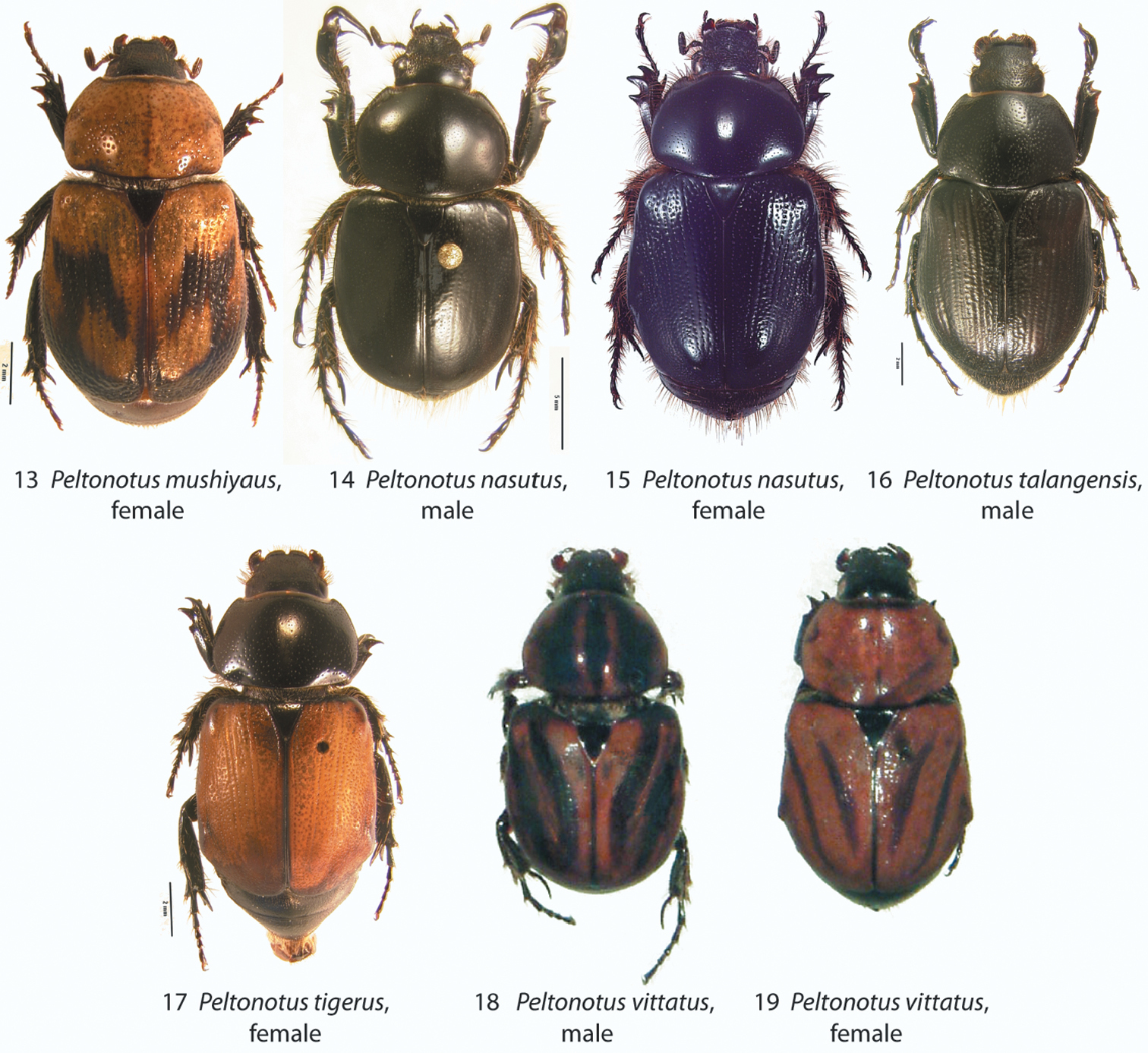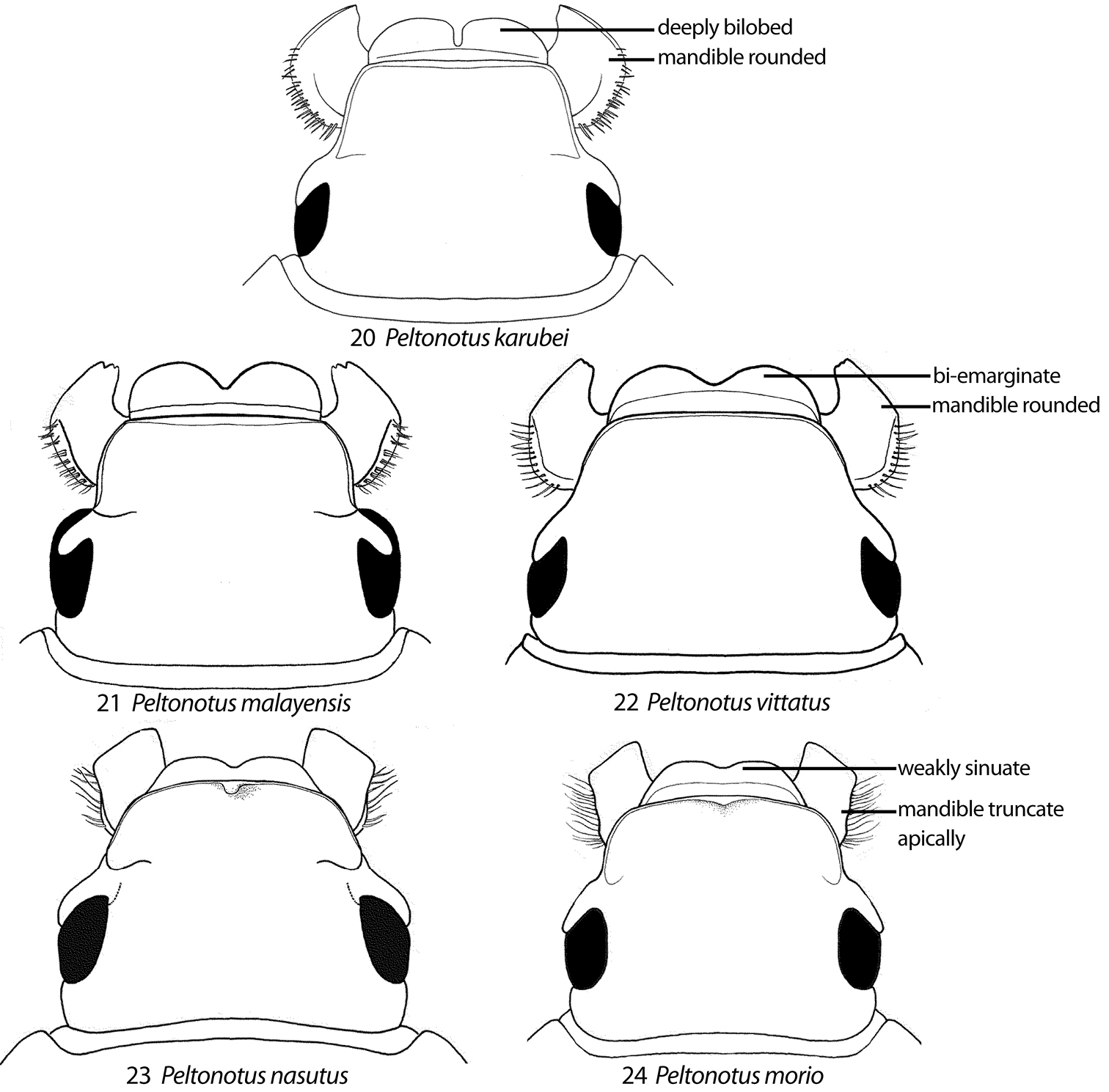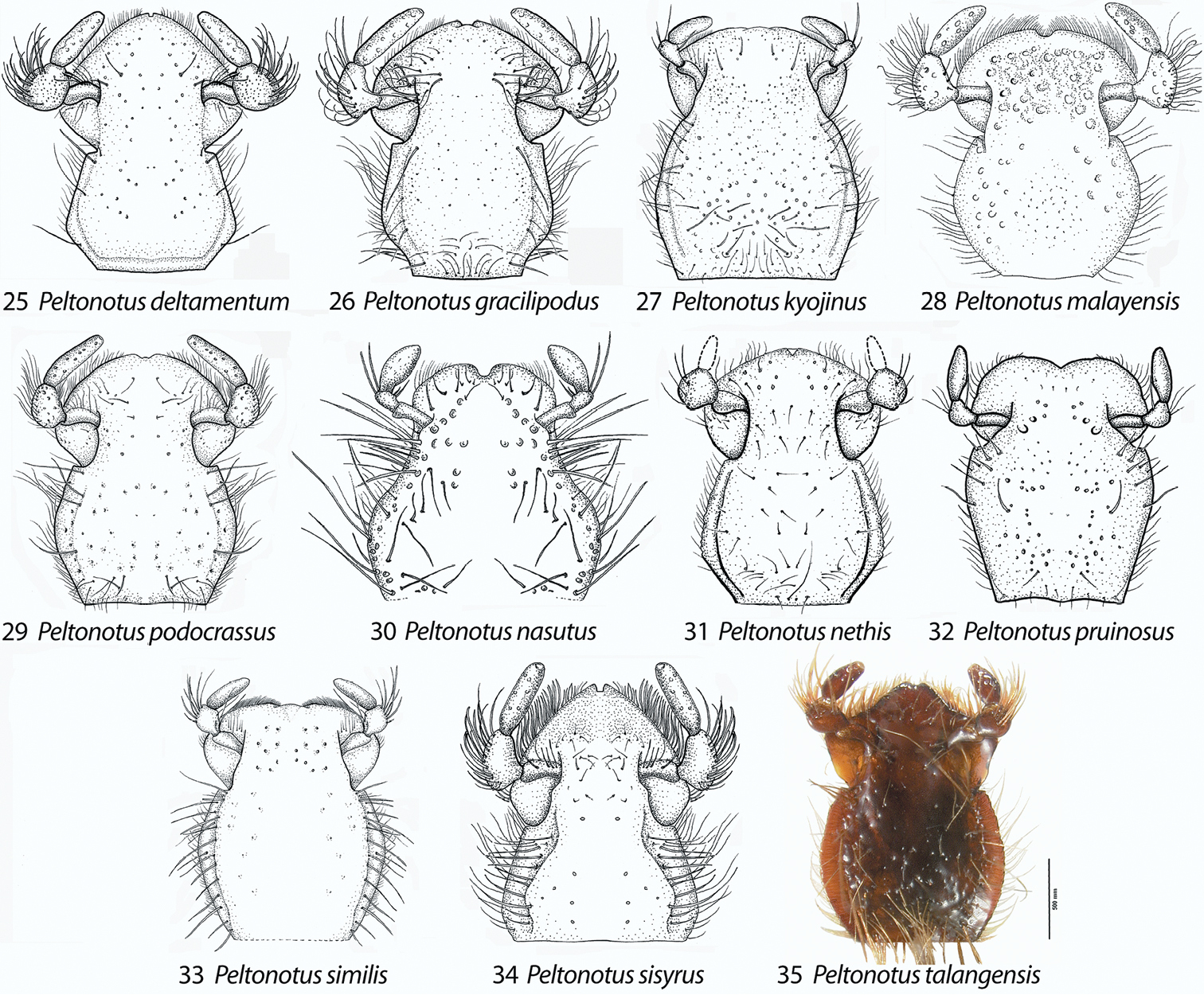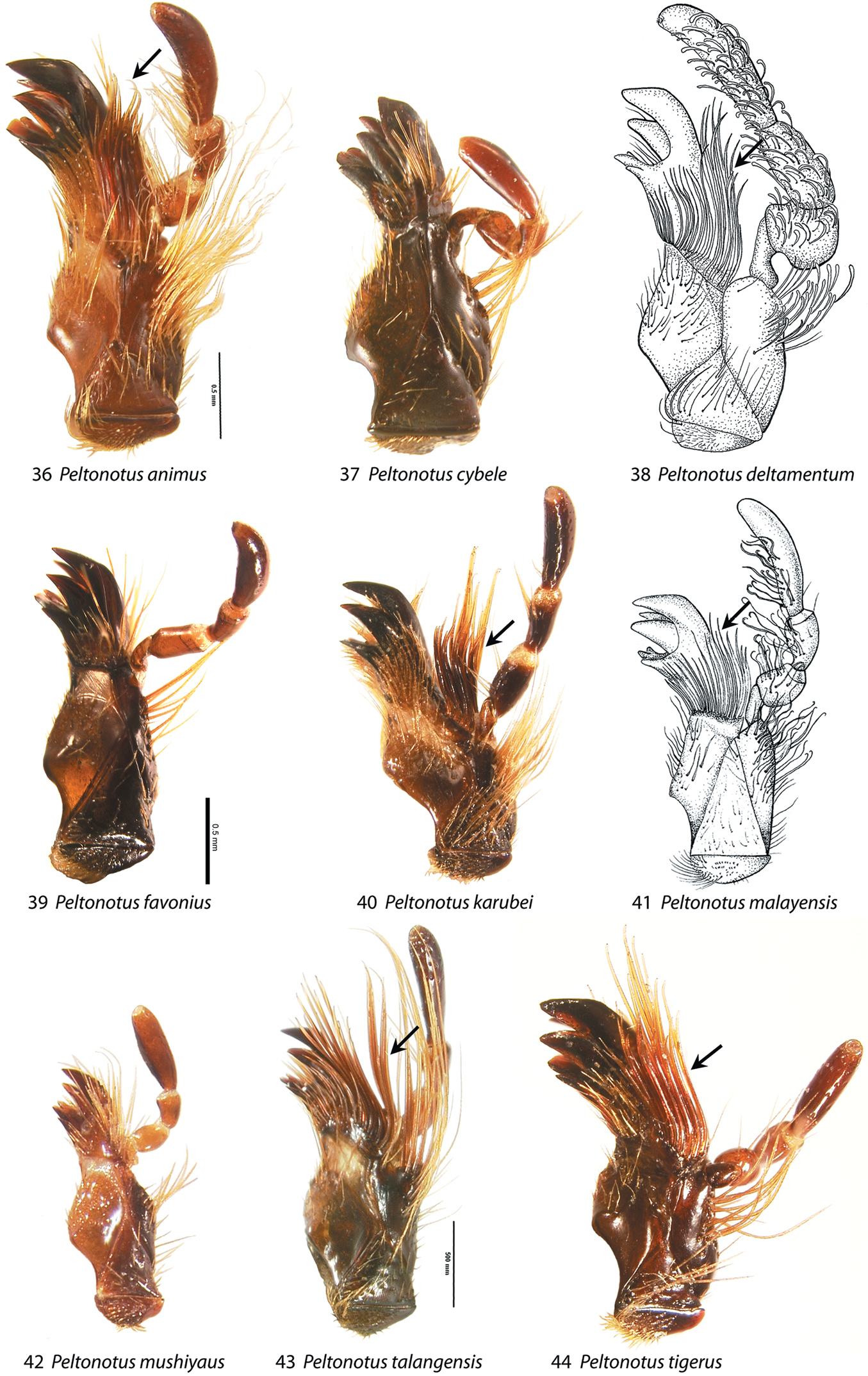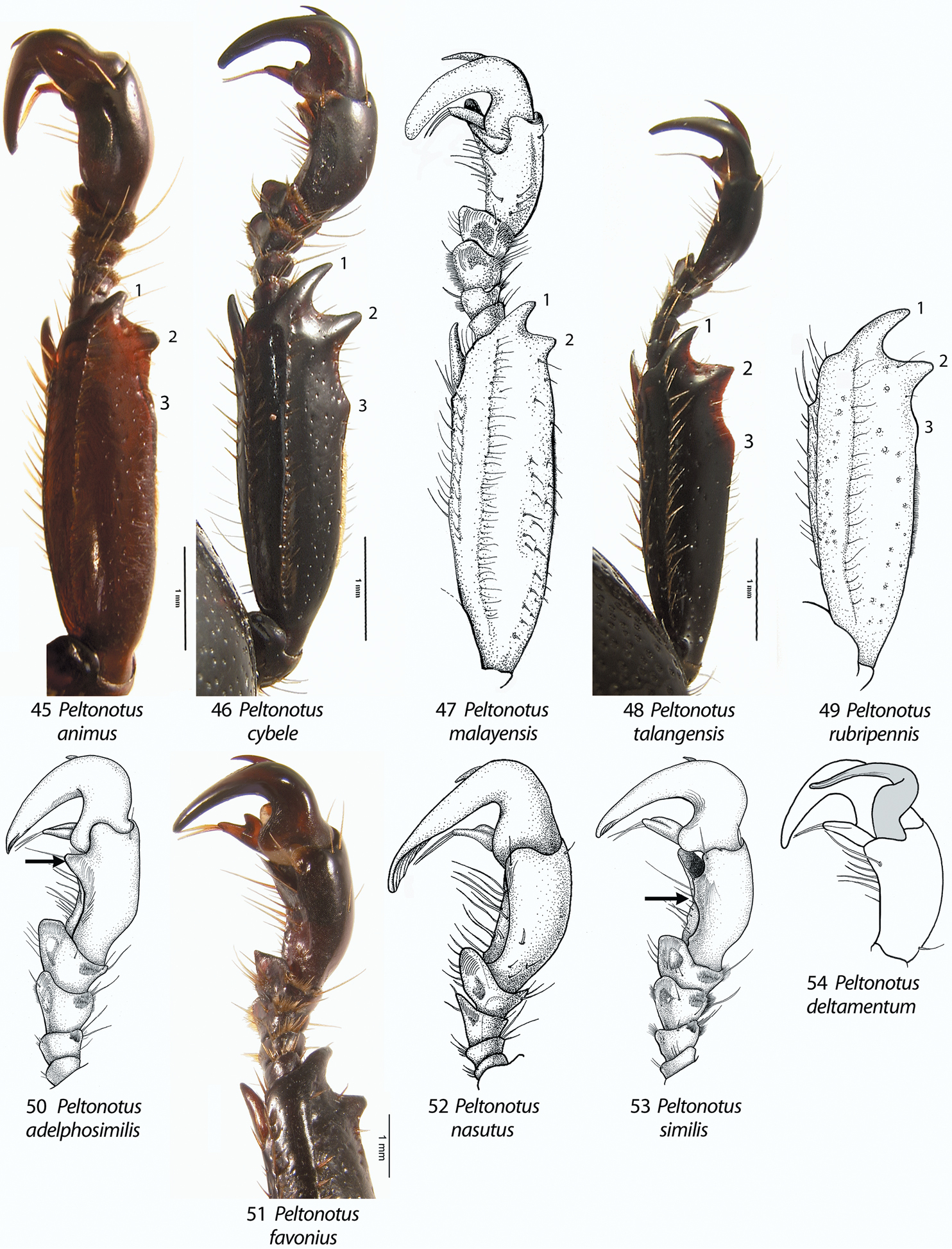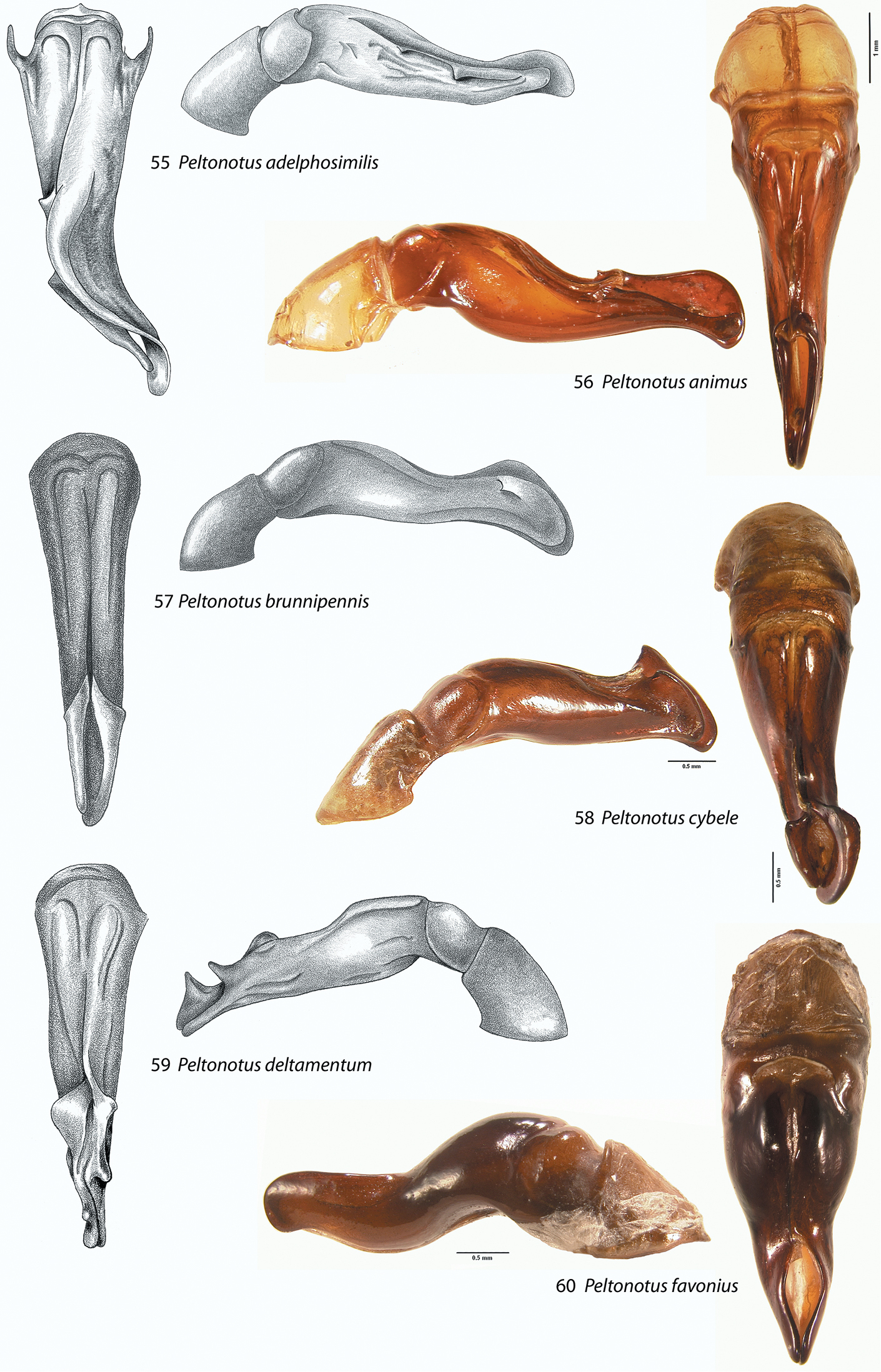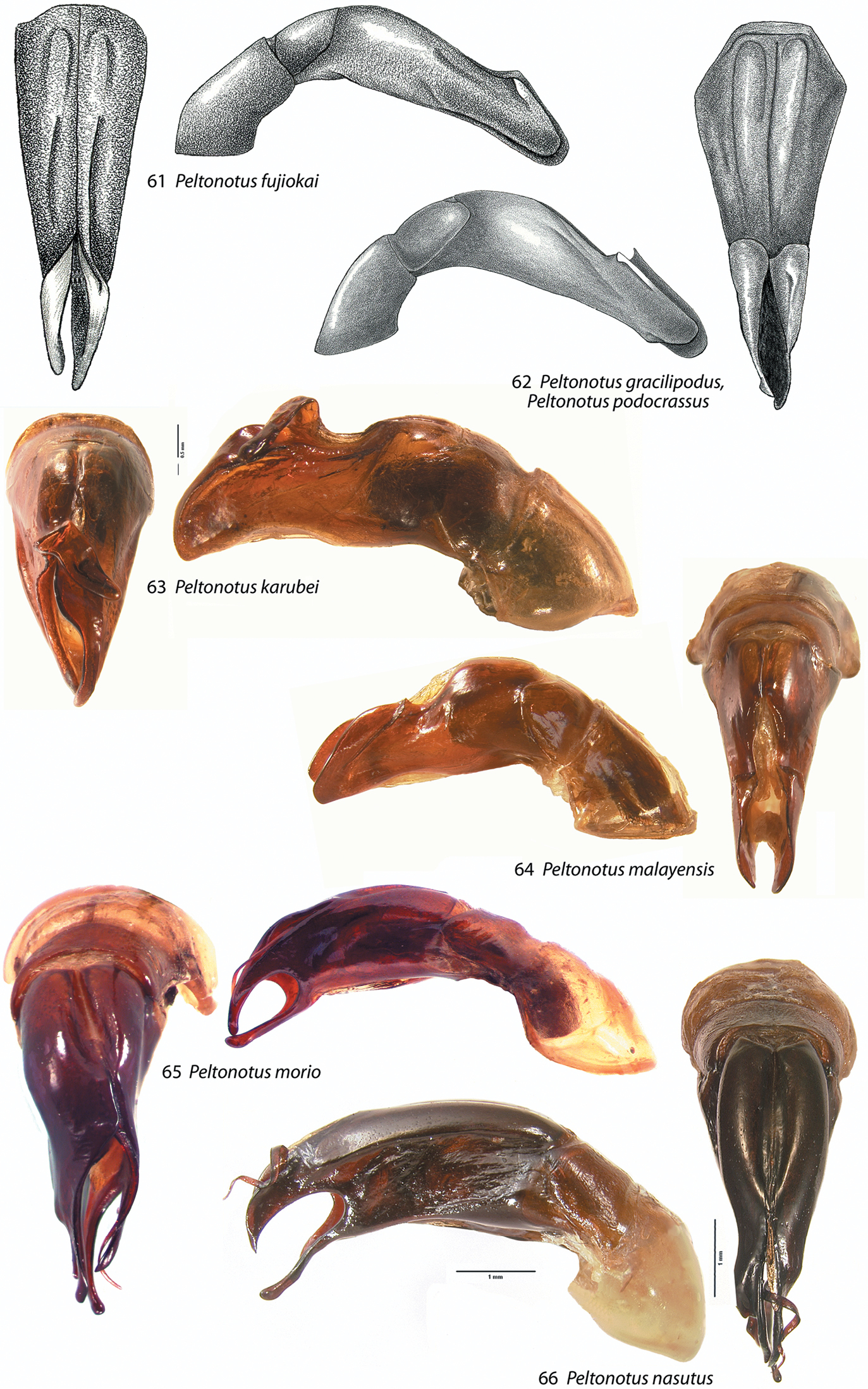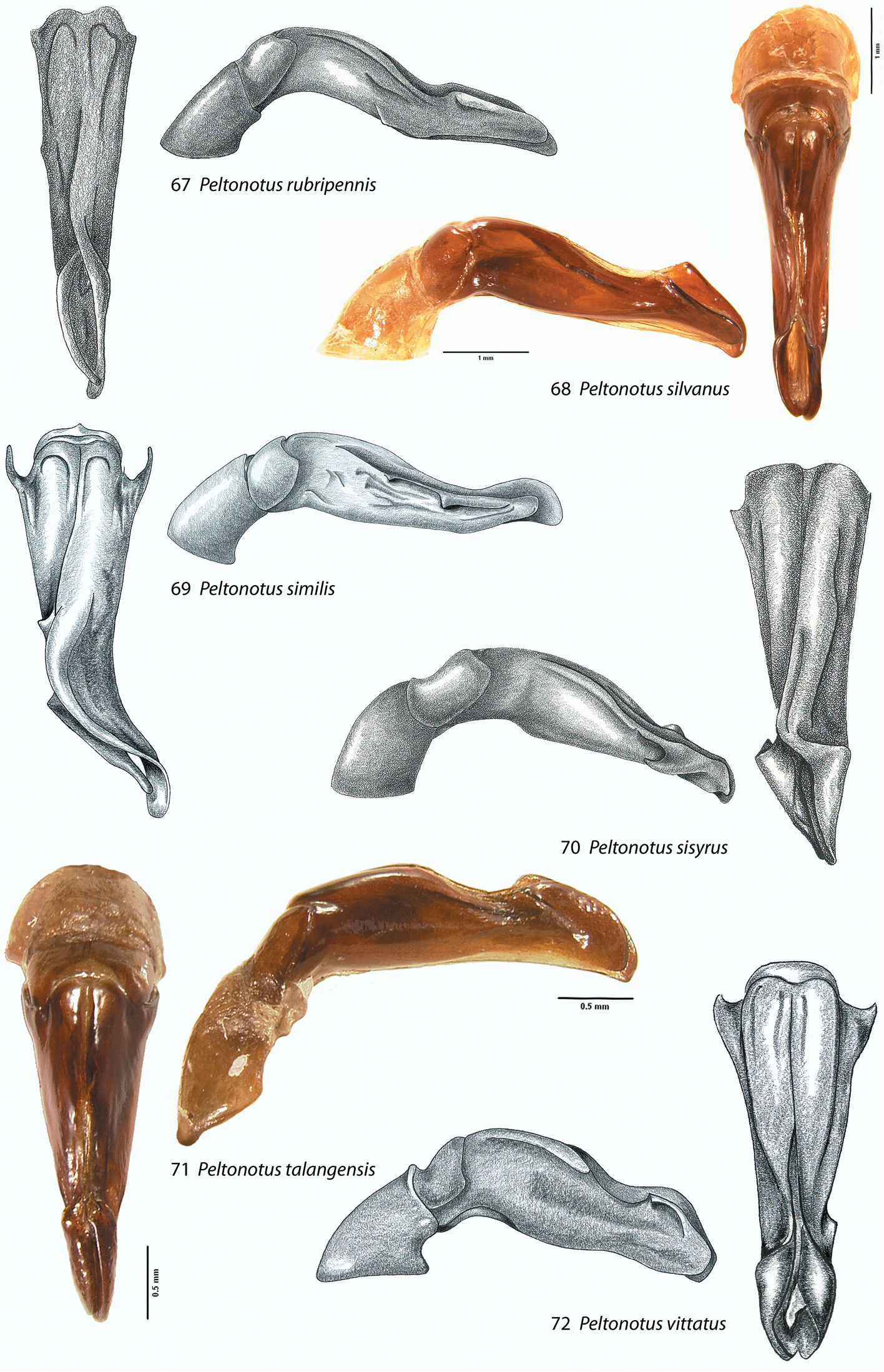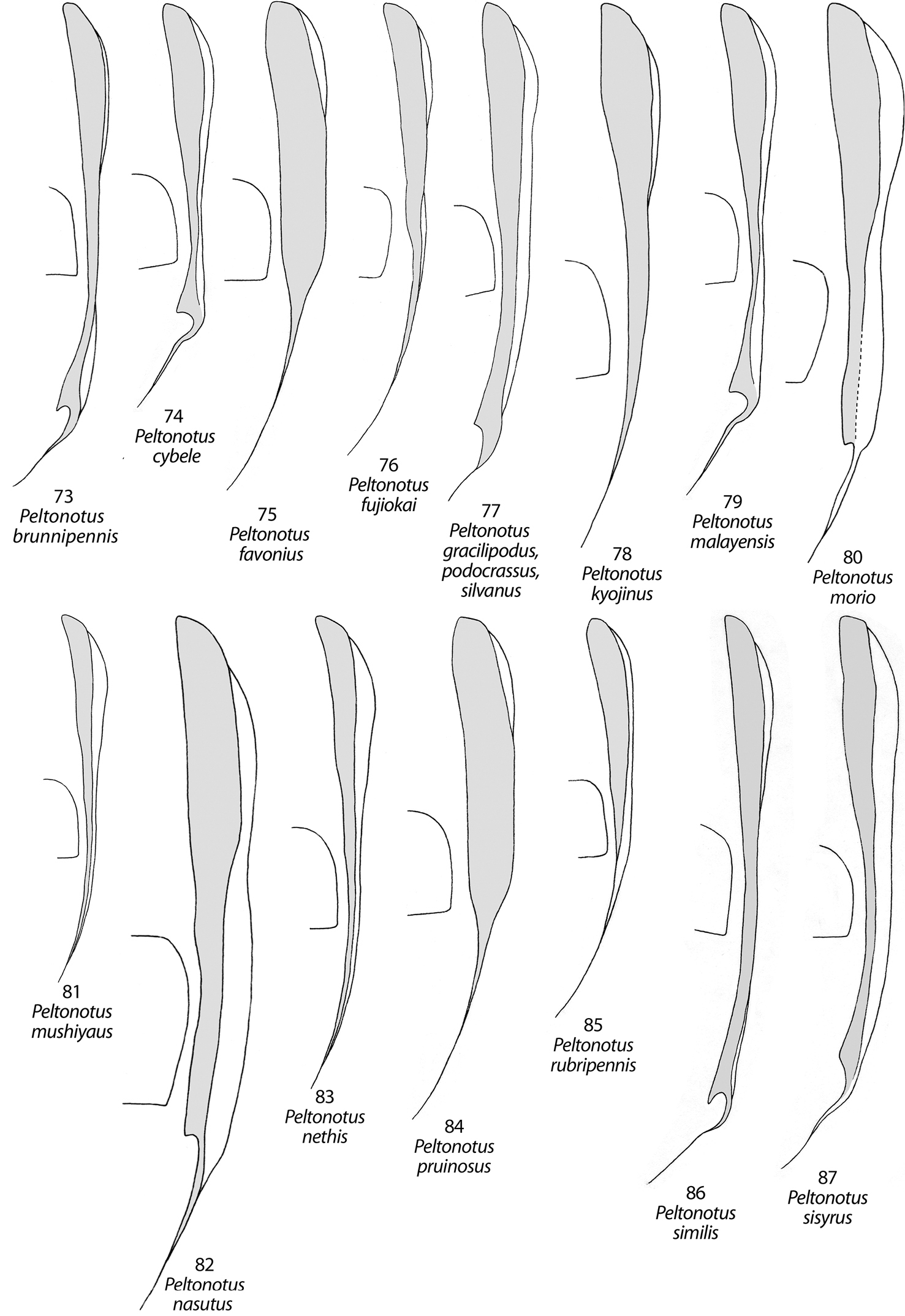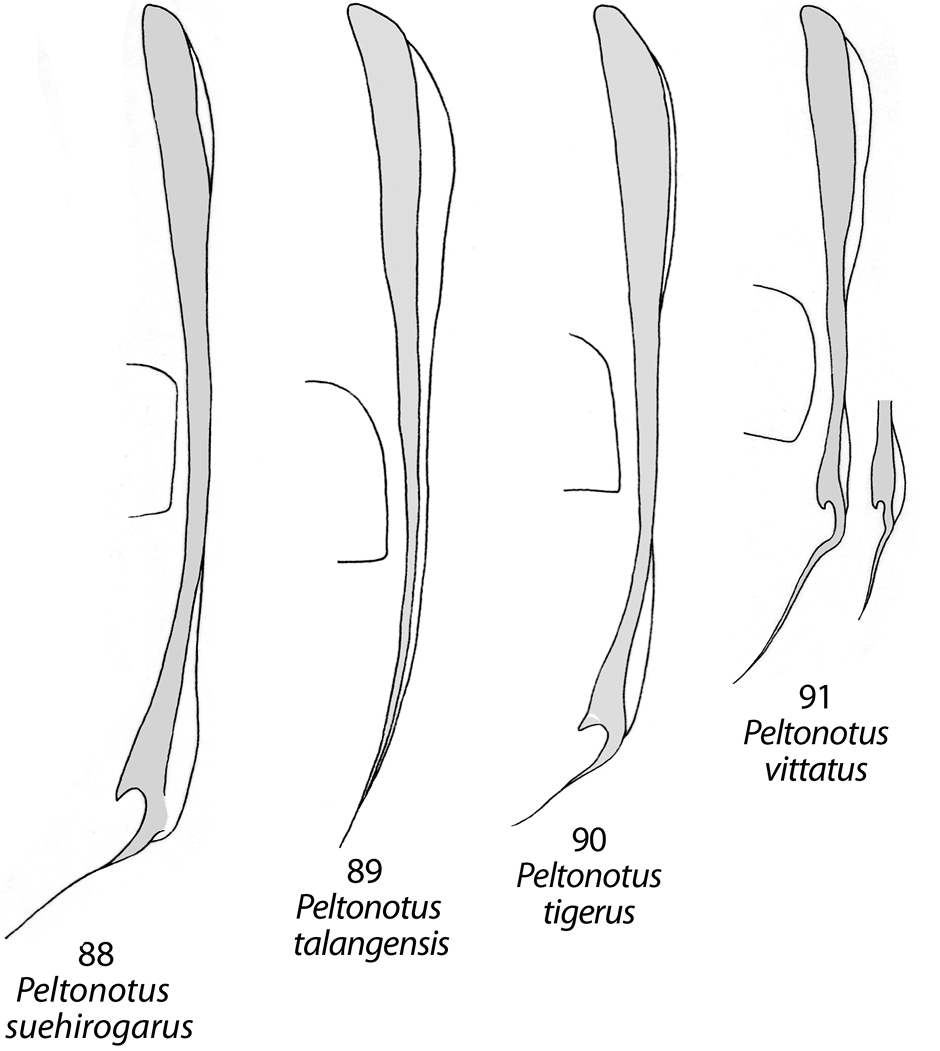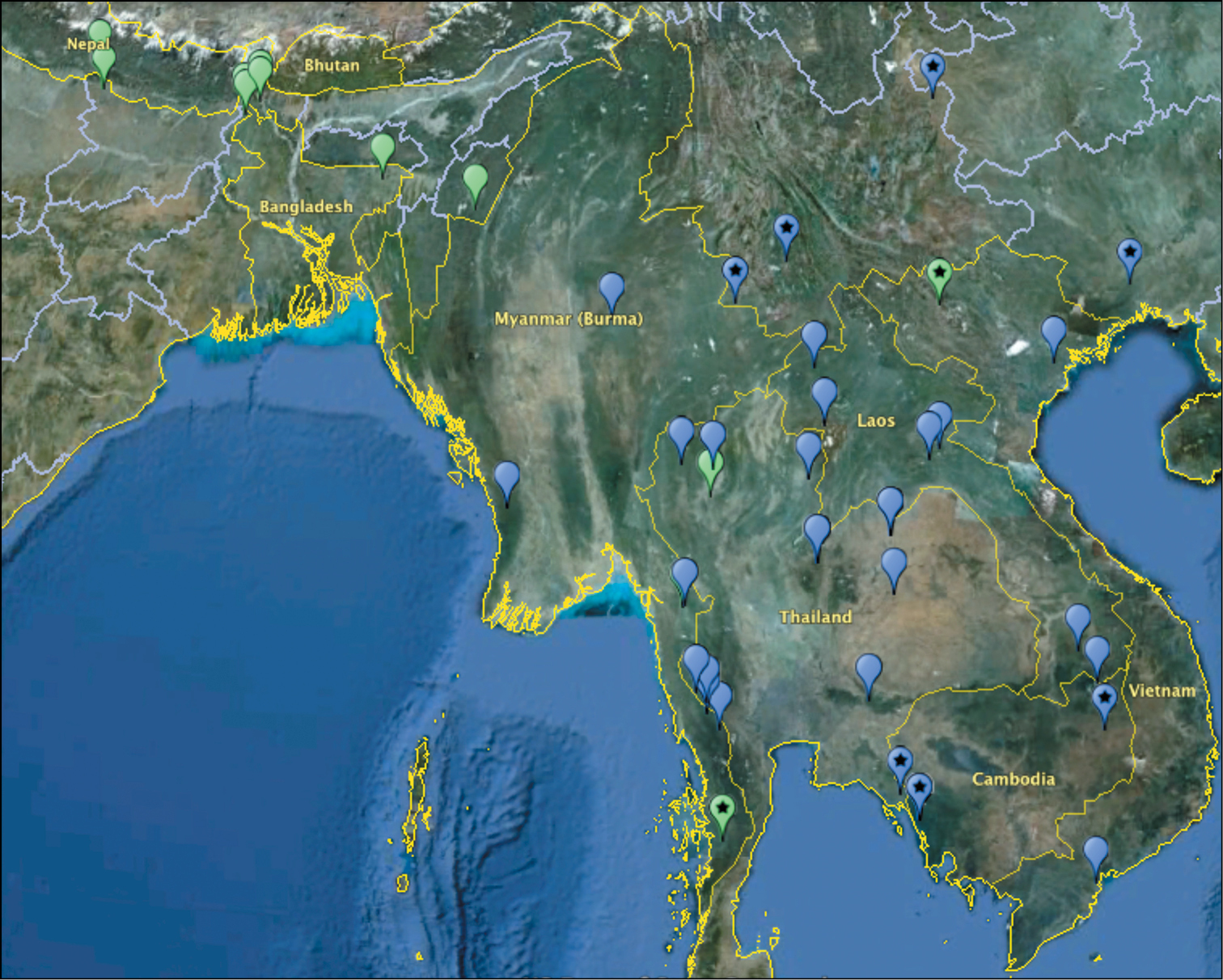






(C) 2013 Mary Liz Jameson. This is an open access article distributed under the terms of the Creative Commons Attribution License 3.0 (CC-BY), which permits unrestricted use, distribution, and reproduction in any medium, provided the original author and source are credited.
For reference, use of the paginated PDF or printed version of this article is recommended.
Citation: Jameson ML, Drumont A (2013) Aroid scarabs in the genus Peltonotus Burmeister (Coleoptera, Scarabaeidae, Dynastinae): key to species and new distributional data. ZooKeys 320: 63–95. doi: 10.3897/zookeys.320.5352
The southeast Asian scarab beetle genus Peltonotus Burmeister (Scarabaeidae, Dynastinae, Cyclocephalini) is reviewed. New country records for Peltonotus morio Burmeister (Myanmar and Vietnam), Peltonotus nasutus Arrow (southern China and Cambodia), and Peltonotus favonius Jameson and Wada (Myanmar) are reported, including a new record in the Palearctic/Sino-Japanese biogeographic region. The first female specimen of Peltonotus favonius is described. Biological associations with aroid inflorescences are reviewed, and human consumption of Peltonotus beetles is reported. A key to all species, paralectotype designations for Peltonotus nasutus, diagnoses, and distributions using dynamic mapping tools are included.
Edible insects, Palearctic region, Sino-Japanese region, Araceae, dynamic mapping
The scarab beetle genus Peltonotus Burmeister (Scarabaeidae, Dynastinae) includes 25 species that are distributed in forest habitats in Southeast Asia and that are associated with aroid inflorescences (Araceae) (
Identification of species in the genus Peltonotus is hampered by sexual dimorphism that makes association of conspecific sexes difficult, absence of male or female specimens for some species, rarity of some species (perhaps due to brief activity patterns and host plant phenology), and color variability within species. For this reason, we amalgamate existing keys into one identification guide for males and females and provide diagnoses.
Species of Peltonotus are associated with aroid inflorescences (Araceae) (
In addition to being associated with aroid inflorescences, adults are attracted to lights at night, and some have been collected in malaise traps. Adults may have short seasonal activity patterns. Some adults have been recorded for only two nights during season-long, intensive collecting efforts. Larvae are not known for any species in the genus.
Survey efforts and collecting in Southeast Asia have provided new distributional data for species in the genus, thus yielding a clearer understanding of distribution patterns. Herein, we report new distributional data for three species of Peltonotus. Because identification of species requires use of three publications (
Characters and specimens were examined using a dissecting microscope (6–48× magnification) and fiber-optic illumination. Digital images of specimens and structures were captured using the Leica Application Suite V3.8. Images were edited in Adobe Photoshop CS2 (background removed, contrast manipulated). In the absence of images for some specimens, illustrations are used. Specimen localities that were not recorded in latitude and longitude on original labels were translated using GoogleEarth (www.google.com/earth/index.html) or by using the Global Gazetteer Version 2.2 (www.fallingrain.com/world/). It should be noted that older localities have a wide margin of error, and their lack of precision is not conducive to ecological or niche modeling. Maps were generated by entering these data into Microsoft Excel 2008 and uploaded to EarthPoint (www.earthpoint.us/Excel-ToKml.aspx) and GoogleEarth (Appendix 1). These mapping tools allow for interactive mapping and addition of data by subsequent users. Locality information in species treatments is recorded with the country in bold letters, followed by the state/province/district, and the specific locality in parentheses.
This work unifies some character state definitions (e.g., form of labrum, male protibial teeth, female elytral epipleural pillow) previously used for identification of Peltonotus species. Species are characterized by combinations of characters including the form of the labrum (weakly sinuate, bi-emarginate/broadly emarginated, or deeply bilobed) (Figs 20–24), mentum apex and second labial palpomere (compared with palpomere 1) (Figs 25–35), mala of maxilla with or without thickened and strongly flattened setae (“lamellate setal brush”) (Figs 36–44), stipes of maxilla with or without curly setae (Figs 36–44), male protibia tri- or bidentate (Figs 45–49), form of male protarsomeres (Figs 50–54), form of the male parameres (Figs 55–72), and form of the female epipleuron in ventral view in relation to the position of the metacoxa (Figs 73–91). Expansions of the female elytral epipleuron may have an inflated area (or pillow) in dorsal view (
We follow the phylogenetic species concept (
Peltonotus nasutus (Figs 14–15) is the most distinctive species within the genus Peltonotus due to its large body size (~20 mm), tubercle at the apex of the clypeus in the male (Fig. 23), and greatly enlarged protibial claw in the male (Fig. 52).
Large aggregations of adults (over 100) have been found in association with the large, fetid-smelling aroids in the genus Amorphophallus (
Peltonotus species dorsal habitus. 1 Peltonotus animus, male 2–3 Peltonotus cybele, male and female (respectively) 4 Peltonotus favonius, male 5–7 Peltonotus fujiokai, males (showing variation) 8 Peltonotus fujiokai, female 9 Peltonotus karubei, male 10–11 Peltonotus malayensis, male and female (respectively) 12 Peltonotus morio, male.
Peltonotus species dorsal habitus. 13 Peltonotus mushiyaus, female 14–15 Peltonotus nasutus, male and female (respectively) 16 Peltonotus talangensis, male 17 Peltonotus tigerus, female 18–19 Peltonotus vittatus, male and female (respectively).
Head (dorsal view) showing characters of the labrum, mandible, and clypeus. 20 Peltonotus karubei (apex of labrum deeply bi-lobed; apex of mandible rounded laterally) 21 Peltonotus malayensis (apex of labrum bi-emarginate; apex of mandible rounded laterally) 22 Peltonotus vittatus (apex of labrum bi-emarginate; apex of mandible rounded laterally) 23 Peltonotus nasutus (apex of labrum weakly sinuate; apex of mandible quadrate laterally with broadly truncate apex; apex of clypeus with weak tubercle in male) 24 Peltonotus morio (apex of labrum weakly sinuate; apex of mandible quadrate laterally with broadly truncate apex; apex of clypeus without tubercle in male).
Mentum, ventral view, showing form of apical half of mentum and form of labial palpomere 2 (in comparison to palpomere 1). 25 Peltonotus deltamentum 26 Peltonotus gracilipodus 27 Peltonotus kyojinus 28 Peltonotus malayensis 29 Peltonotus podocrassus 30 Peltonotus nasutus 31 Peltonotus nethis 32 Peltonotus pruinosus 33 Peltonotus similis 34 Peltonotus sisyrus 35 Peltonotus talangensis.
Maxilla, ventral view, showing mala with or without lamellate setal brush (setae thick and strongly flattened), and showing stipes with or without setae curly at apices. 36 Peltonotus animus 37 Peltonotus cybele 38 Peltonotus deltamentum 39 Peltonotus favonius 40 Peltonotus karubei 41 Peltonotus malayensis 42 Peltonotus mushiyaus 43 Peltonotus talangensis 44 Peltonotus tigerus. Arrows indicate lamellate setal brush.
Male prolegs, dorsal view (45–49), male protarsomeres, dorsal view (50–53), and male protarsomere 5, ventral view (54), of Peltonotus. 45 Peltonotus animus (male protibia tridentate with basal tooth obsolete) 46 Peltonotus cybele (male protibia tridentate with basal tooth well developed) 47 Peltonotus malayensis (male protibia bidentate) 48 Peltonotus talangensis (male protibia tridentate with basal tooth well developed) 49 Peltonotus rubripennis (male protibia tridentate with basal tooth weakly developed) 50 Peltonotus adelphosimilis (arrow showing protarsomere 5 of male with internoapical protuberance) 51 Peltonotus favonius (male protibia bidentate) 52 Peltonotus nasutus (male protibial claw greatly enlarged) 53 Peltonotus similis (arrow showing protarsomere 5 of male with internomedial protuberance) 54 Peltonotus deltamentum (male proclaw strongly arcuate in ventral view).
Male parameres (with or without phallobase), dorsal and lateral views, in Peltonotus. Male parameres are highly asymmetrical, and we illustrate the lateral view that best assists in identification. 55 Peltonotus adelphosimilis 56 Peltonotus animus 57 Peltonotus brunnipennis 58 Peltonotus cybele 59 Peltonotus deltamentum 60 Peltonotus favonius.
Male parameres (with or without phallobase), dorsal and lateral views, in Peltonotus. Male parameres are highly asymmetrical, and we illustrate the lateral view that best assists in identification. 61 Peltonotus fujiokai 62 Peltonotus gracilipodus and Peltonotus podocrassus 63 Peltonotus karubei 64 Peltonotus malayensis 65 Peltonotus morio 66 Peltonotus nasutus.
Male parameres (with or without phallobase), dorsal and lateral views, in Peltonotus. Male parameres are highly asymmetrical, and we illustrate the lateral view that best assists in identification. 67 Peltonotus rubripennis 68 Peltonotus silvanus 69 Peltonotus similis 70 Peltonotus sisyrus 71 Peltonotus talangensis 72 Peltonotus vittatus.
Female elytral epipleuron (gray, ventral view) and position relative to metacoxa in Peltonotus. 73 Peltonotus brunnipennis 74 Peltonotus cybele 75 Peltonotus favonius 76 Peltonotus fujiokai 77 Peltonotus gracilipodus, Peltonotus podocrassus and Peltonotus silvanus 78 Peltonotus kyojinus 79 Peltonotus malayensis 80 Peltonotus morio 81 Peltonotus mushiyaus 82 Peltonotus nasutus 83 Peltonotus nethis 84 Peltonotus pruinosus 85 Peltonotus rubripennis 86 Peltonotus similis 87 Peltonotus sisyrus
Female elytral epipleuron (gray, ventral view) and position relative to metacoxa in Peltonotus. 88 Peltonotus suehirogarus 89 Peltonotus talangensis 90 Peltonotus tigerus 91 Peltonotus vittatus.
The species is distributed in Myanmar, Thailand, Laos, and Vietnam (
Distribution of Peltonotus morio (green icon) and Peltonotus nasutus (blue icon) in southeast Asia. Icons with stars indicate new country records for each species. Map was generated using data in Table 1.
Peltonotus Locality Table. Locality information for Peltonotus morio and Peltonotus nasutus. The Appendix file can be used for dynamic mapping using EarthPoint and GoogleEarth.
| Latitude, Longitude | Species name | Collection or Reference | Locality Information |
|---|---|---|---|
| 16°40'27"N, 98°17'59"E | Peltonotus morio | FUJI | S. Burma, Mt. Dawna, V.1992, 1 male, ele. 763m, NEW COUNTRY RECORD |
| 12°05'N, 99°00'E | Peltonotus morio | FUJI | S. Burma, Tenasserim, V.1992, 1 female, NEW COUNTRY RECORD |
| 26°52'41"N, 88°17'25"E | Peltonotus morio | BMNH | India, Kurseong Div., Lat Panchar, 4000 ft., VI.1934, 6 specimens, Col. Champion |
| 27°39'N, 84°19'E | Peltonotus morio | Nepal, Chitwan Central region, Gunjanagar, 230 m | |
| 27°39'N, 84°21'E | Peltonotus morio | Nepal, Rampur, 230 m, amid maize-maize-vegetables in sandy soil from farming sites. | |
| 22°29'N, 103°57'E | Peltonotus morio | IRSBN | Vietnam, Lao Cai Prov., VI.10.1917, 1 male NEW COUNTRY RECORD |
| 18°49'16"N, 98°55'11"E | Peltonotus morio | Thailand, Doi Suthep | |
| 27°18'42"N, 88°35'57"E | Peltonotus morio | Sikkim, India | |
| 24°39'32"N, 93°54'22"E | Peltonotus morio | India, Manipur | |
| 25°22'05"N, 91°45'13"E | Peltonotus morio | India, Meghalaya, Khasi Hills | |
| 27°09'33"N, 88°36'56"E | Peltonotus morio | India, Pedong | |
| 27°02'09"N, 88°14'08"E | Peltonotus morio | India, Darjeeling | |
| 28°16'N, 84°05'E | Peltonotus morio | Nepal, Chhachok | |
| 14°48'00"N, 106°49'59"E | Peltonotus nasutus | FUJI | S. Laos, Attapu, V.13.2007, 1 male, 1 female, ele 450m |
| 14°88'N, 105°87'E | Peltonotus nasutus | FUJI | S. Laos, Champasak Province, 2 females, |
| 16°42'18"N, 98°20'44"E | Peltonotus nasutus | FUJI | S. Burma, Mt. Dawna, V.1992, 1 female |
| 18°38'31"N, 94°42'56"E | Peltonotus nasutus | FUJI | Myanmar, Arakan Province, Nianjyo, 1070m, 1 male, 1 female |
| 15°N, 98°32'E | Peltonotus nasutus | BMNH | W. Thailand, Kanchanaburi Prov., Thung Yai Wildlife Sanctuary, mixed riverside forest, M. Brendell, V.8.1988, 10 specimens, within spathe of Amorphophallus inflorescence |
| 19°25'N, 103°30'E | Peltonotus nasutus | BMNH | Laos, Xiankhouang Prov. V.18.1919, 1 male |
| 26°51'22"N, 104°13'59"E | Peltonotus nasutus | Drumont | Chine, Guizhou, Mt. Ping-Qing-Liang-Zi, Weining county, 1-10/VII-2009, 1 male, 3 female NEW COUNTRY RECORD |
| 23°28'5"N, 100°41'E | Peltonotus nasutus | Drumont | Chine, Yunnan, Mt. Longtanshan, Jinggu county, VI.11-20, 3 male, Col. Li Jingke NEW COUNTRY RECORD |
| 22°35'N, 99°33'E | Peltonotus nasutus | Drumont | Chine, Yunnan, Mt. Daheishan, Menglian county, V.20-31-2009, Col. Li Jingke, 1 female NEW COUNTRY RECORD |
| 22°47'56"N, 108°19'44"E | Peltonotus nasutus | AREC | China, Guangxi Zhuang Automonus Region NEW COUNTRY RECORD |
| 17°28'59"N, 101°4'0"E | Peltonotus nasutus | IRSBN | Thailand, Changwat Loei, Na Haeo Bio. Sta., V-15-19-2003, light trap, Col. Constant, Smets, and Grootaert, 1 male, 2 female |
| 17°28'59"N, 101°4'0"E | Peltonotus nasutus | IRSBN | Thailand, Changwat Loei, Na Haeo Bio. Sta., V.17.2003, edge pond, Col. Constant and Smets, 2 female |
| 17°28'59"N, 101°4'0"E | Peltonotus nasutus | IRSBN | Thailand, Changwat Loei, Na Haeo Bio. Sta., V.5-12-2001, light trap, Col. Constant and Grootaert, 2 female |
| 19°27'N, 98°20'E | Peltonotus nasutus | IRSBN | N. Thailand, Mae Hong Son Prov., 600 m, 28-V to 2-VI-1999, Col. D. Hauck, 2 male, 2 female |
| 14°16'07"N, 98°59'12"E | Peltonotus nasutus | IRSBN | Thailand, Kanchanaburi Prov., Sai Yok NP, VI.4–5.2003, Constant and Smets, 1 male, 1 female |
| 13°49'59"N, 106°57'0"E | Peltonotus nasutus | IRSBN | Cambodia, Ratanakiri Prov., Phumi Kalai Thum., VI.1-19.2007, Col. Li Jingke, 1 male, 2 female NEW COUNTRY RECORD |
| 12°18'09"N, 102°59'20"E | Peltonotus nasutus | IRSBN | Cambodia, Pursat Prov., Phnum Samkos Wildlife Sanctuary, XI.15, 2005, light trapping, col. Smets and Van, 5 male, 4 female NEW COUNTRY RECORD |
| 12°18'09"N, 102°59'20"E | Peltonotus nasutus | IRSBN | Cambodia, Pursat Prov., Phnum Samkos Wildlife Sanctuary, IV.13-14, 2005, light trapping, primary forest edge, col. Smets and Van, 1 female, 1 male, |
| 12°18'09"N, 102°59'20"E | Peltonotus nasutus | IRSBN | Cambodia, Pursat Prov., Phnum Samkos Wildlife Sanctuary, IV.16, 2005, light trapping, col. Smets and Van, 3 female, 1 male NEW COUNTRY RECORD |
| 12°18'09"N, 102°59'20"E | Peltonotus nasutus | IRSBN | Cambodia, Pursat Prov., Phnum Samkos Wildlife Sanctuary, IV.15, 2005, light trapping, col. Smets and Van, 1 female NEW COUNTRY RECORD |
| 12°51'2"N, 102°36'34"E | Peltonotus nasutus | Drumont | Cambodia, Pailin Prov., 270m, V.6-16.2008, col. Murzin, 2 female NEW COUNTRY RECORD |
| 21°17'13"N, 101°10'02"E | Peltonotus nasutus | IRSBN | NW Laos, Louang Namtha Prov., Muang Sing, Houaylong-Kao, VI.2-19.2010, 6 male, 16 female |
| 17°58'0"N, 102°35'59"E | Peltonotus nasutus | IRSBN | Laos, Vientiane Prov., IV.4-1915, 1 female |
| 17°58'0"N, 102°35'59"E | Peltonotus nasutus | IRSBN | Laos, Vientiane Prov., V.18-1915, 1 male |
| 20°09'0"N, 101°19'53"E | Peltonotus nasutus | Laos, Bokeo Prov., Pha Ngam | |
| 16°46'30"N, 102°37'10"E | Peltonotus nasutus | Thailand, Khorat | |
| 14°35'21"N, 98°44'29"E | Peltonotus nasutus | Thailand, Pu Nam Long Hot Spring | |
| 14°47'53"N, 98°44'29"E | Peltonotus nasutus | Thailand, Khao Leam Dam | |
| 19°05'47"N, 100°57'09"E | Peltonotus nasutus | Thailand, Nan Province | |
| 19°21'46"N, 98°59'01"E | Peltonotus nasutus | Thailand, Ban Chiang Dao | |
| 14°43'02"N, 102°01'23"E | Peltonotus nasutus | Thailand, Khorat Prov., Pak Thong Chai | |
| 17°57'46"N, 102°36'54"E | Peltonotus nasutus | Laos, Vientane | |
| 19°36'41"N, 103°43'44"E | Peltonotus nasutus | Laos, Xiangkhouang | |
| 22°20'59"N, 96°55'00"E | Peltonotus nasutus | Myanmar, Gokhteik | |
| 21°14'14"N, 106°22'34"E | Peltonotus nasutus | Vietnam, Tonkin (north Vietnam) | |
| 10°44'57"N, 106°40'43"E | Peltonotus nasutus | Vietnam, Cochinchina (southern Vietnam) |
During the course of our research, we discovered two unrecorded paralectotype specimens. The male lectotype (at BMNH) and eight paralectotypes (6 at BMNH, 2 at MNHN) were previously designated (
Peltonotus favonius Jameson and Wada (Fig. 4) was previously known based only on one male specimen from Vietnam (
Peltonotus morio Burmeister (Fig. 12) is the type species for the genus Peltonotus and is one of the most wide-spread species in the genus (Fig. 92). It is distinguished from its close congener, Peltonotus nasutus Arrow (Figs 14–15), by its incomplete pronotal basal bead (complete in Peltonotus nasutus), form of the male parameres (Figs 65–66), lack of a small tubercle at the apex of the clypeus in the male (Fig. 24) (present in Peltonotus nasutus [Fig. 23]), and form of the epipleuron in females (Figs 80 versus 82).
The species is found in northeastern India, Nepal, Bhutan, and Thailand (
Males: Protibial claws with one claw enlarged and expanded; elytral epipleuron not developed in ventral view. Males of Peltonotus kyojinus, Peltonotus nethis, Peltonotus pruinosus, Peltonotus suehirogarus, Peltonotus mushiyaus, and Peltonotus tigerus are not known.
| 1 | Apical half of mentum acute, triangular (e.g., Figs 25, 34–35) | 2 |
| – | Apical half of mentum rounded (Figs 26–29, 31–33) or quadrate (Fig. 30) | 4 |
| 2 | Punctures of frons and clypeus unisetigerous; parameres as in Fig. 71 | Peltonotus talangensis Jameson & Jakl |
| – | Punctures of frons and clypeus multisetigerous (at least laterally); parameres not as in Fig. 71 | 3 |
| 3 | Smaller protarsal claw deeply arcuate (Fig. 54); parameres as in Fig. 59 | Peltonotus deltamentum Jameson & Wada |
| – | Smaller protarsal claw simply arched; parameres as in Fig. 70 | Peltonotus sisyrus Jameson & Wada |
| 4 | Apex of labrum weakly sinuate (Figs 23–24) | 5 |
| – | Apex of labrum bi-emarginate (Figs 21–22) to deeply bilobed (Fig. 20) | 6 |
| 5 | Protibia tridentate with well-developed basal tooth (e.g., Fig. 46); apex of clypeus at middle with tubercle (Fig. 23); parameres as in Fig. 66 | Peltonotus nasutus Arrow |
| – | Protibia tridentate with weakly developed basal tooth (e.g., Fig. 49); apex of clypeus lacking tubercle (Fig. 24); parameres as in Fig. 65 | Peltonotus morio Burmeister |
| 6 | Labrum with apex deeply bilobed (e.g., Fig. 20) | 7 |
| – | Labrum with apex bi-emarginate (Figs 21–22) | 10 |
| 7 | Mala of maxilla with setae thick and strongly flattened (with well developed lamellate setal brush); Borneo, Malaysia, and Sumatra; parameres not as in Fig. 63 | 8 |
| – | Mala of maxilla with setae not thick and strongly flattened (lacking well developed lamellate setal brush) (Fig. 40); South Vietnam; parameres as in Fig. 63 | Peltonotus karubei Muramoto |
| 8 | Punctures of frons lacking setae; parameres as in Fig. 57 | Peltonotus brunnipennis Benderitter |
| – | Punctures of frons with dense, velutinous and/or moderately long setae; parameres not as in Fig. 57 | 9 |
| 9 | Protarsus with larger claw gracile, subequal at middle and base; maxillary stipes with setae curly at apex (e.g., Fig. 41); Sarawak | Peltonotus gracilipodus Jameson & Wada |
| – | Protarsus with larger claw robust, much wider at middle than at base; maxillary stipes with setae straight, not curly at apex; Malaysia (Cameron Highlands) | Peltonotus podocrassus Jameson & Wada |
| 10 | Labial palpomere 2 greatly enlarged and dorsoventrally flattened, 2–3 times wider than apical palpomere 1 (Fig. 28) | 11 |
| – | Labial palpomere 2 not greatly enlarged and flattened, less than 1.5 times wider than apical palpomere 1 (Fig. 33) | 13 |
| 11 | Maxillary stipes with setae curly at apex (e.g., Fig. 36); parameres not as in Fig. 68 | 12 |
| – | Maxillary stipes with setae straight, not curly at apex; parameres as in Fig. 68 | Peltonotus silvanus Jameson & Wada |
| 12 | Elytral color reddish, lighter in color than pronotum and scutellum; punctures of pygidium multisetigerous, setae minute and moderate in length; parameres as in Fig. 64 | Peltonotus malayensis Arrow |
| – | Elytral color castaneous, similar in color to pronotum and scutellum (Fig. 1); punctures of pygidium unisetigerous, setae moderate in length; parameres as in Fig. 56 | Peltonotus animus Jameson & Wada |
| 13 | Protibia tridentate, basal tooth well developed or weakly developed (Figs 46, 48, 49) | 14 |
| – | Protibia bidentate (Fig. 47, 51) | 15 |
| 14 | Protibia with basal tooth well developed (Figs 46, 48), external margin without velutinous setae from middle to near base; parameres as in Fig. 61 | Peltonotus fujiokai Jameson & Wada |
| – | Protibia externally with basal tooth weakly developed (Fig. 49), external margin with velutinous setae from middle to near base; parameres as in Fig. 67 | Peltonotus rubripennis Miyake & Yamaya |
| 15 | Elytra reddish with castaneous vittae (Figs 18–19); parameres as in Fig. 72 | Peltonotus vittatus Arrow |
| – | Elytra lacking vittae, entirely reddish, castaneous, or black; parameres not as in Fig. 72 | 16 |
| 16 | Pronotal basal bead lacking, terminating at basolateral angle; length less than 15.0 mm; parameres as in Fig. 60 | Peltonotus favonius Jameson & Wada |
| – | Pronotal basal bead present, extending beyond basolateral angle (obscured anterior to scutellum); length greater than 17.0 mm; parameres not as in Fig. 60 | 17 |
| 17 | Protarsomere 5 with well-developed internoapical protrusion (Fig. 50), lacking weak medial protrusion; region surrounding Mt. Bawang, Kalimantan | Peltonotus adelphosimilis Jameson & Wada |
| – | Protarsomere 5 lacking internoapical protrusion; weak protrusion at middle (Fig. 53); Sabah | Peltonotus similis Arrow |
Females: Protibial claws similar in size and shape; elytral epipleuron developed or simple in ventral view. Females of Peltonotus deltamentum, Peltonotus karubei, and Peltonotus animus are not known.
| 1 | Apical half of mentum acute, triangular (Figs 25, 34–35) | 2 |
| – | Apical half of mentum rounded (Figs 26–29, 31–33) or quadrate (Fig. 30) | 3 |
| 2 | Punctures of frons and clypeus multisetigerous | Peltonotus sisyrus Jameson & Wada |
| – | Punctures of frons and clypeus unisetigerous | Peltonotus talangensis Jameson & Jakl |
| 3 | Apex of labrum weakly sinuate (Figs 23–24) | 4 |
| – | Apex of labrum bi-emarginate (Figs 21–22) to deeply bilobed (Fig. 20) | 5 |
| 4 | Apex of clypeus with weak, medial tubercle; lateral pillow of elytron (dorsal view) elongate-oval, extending more than half length of epipleuron; epipleuron as in Fig. 82 | Peltonotus nasutus Arrow |
| – | Apex of clypeus lacking weak tubercle; lateral pillow of elytron (dorsal view) narrower at apex and broader at base, extending less than half length of epipleuron; epipleuron as in Fig. 80 | Peltonotus morio Burmeister |
| 5 | Elytra with castaneous vittae or maculae (e.g., Figs 13, 18–19) | 6 |
| – | Elytra lacking vittae, entirely castaneous, reddish, or black | 7 |
| 6 | Elytral epipleuron in ventral view simple, lacking apical incision (Fig. 81) | Peltonotus mushiyaus Jameson & Wada |
| – | Elytral epipleuron in ventral view incised at apex (Fig. 91) | Peltonotus vittatus Arrow |
| 7 | Labrum with apex deeply bilobed (e.g., Fig. 20) | 8 |
| – | Labrum with apex bi-emarginate (e.g., Figs 21–22) | 13 |
| 8 | Elytral epipleuron in ventral view simple, not emarginated (Fig. 83) | Peltonotus nethis Jameson & Wada |
| – | Elytral epipleuron in ventral view emarginated (e.g., Fig. 73) | 9 |
| 9 | Maxillary stipes with setae curly at apex (e.g., Fig. 41) | 10 |
| – | Maxillary stipes with setae straight, not curly at apex | 11 |
| 10 | Epipleural emargination with well-developed tooth in ventral view (Fig. 73) | Peltonotus brunnipennis Benderitter |
| – | Epipleural emargination with moderately developed tooth in ventral view (Fig. 77) | Peltonotus gracilipodus Jameson & Wada |
| 11 | Elytra entirely reddish (Fig. 17) | Peltonotus tigerus Jameson & Wada |
| – | Elytra entirely black | 12 |
| 12 | Lateral pillow of elytron (dorsal view) well-developed, extending medially at least ¼ elytral width, visible in ventral view (Fig. 88) | Peltonotus suehirogarus Jameson & Wada |
| – | Lateral pillow of elytron (dorsal view) moderately developed, extending medially about 1/8 elytral width, not visible in ventral view (Fig. 77) | Peltonotus podocrassus Jameson & Wada |
| 13 | Elytral epipleuron in ventral view broad, nearly parallel from base to near metacoxa, lacking emargination (Fig. 75, 84) | 14 |
| – | Elytral epipleuron in ventral view narrowing from base to near metacoxa (not parallel-sided), with or without emargination (e.g., Figs 76, 78–79) | 15 |
| 14 | Elytral epipleuron in ventral view with sparse, reddish, moderately long setae | Peltonotus favonius Jameson & Wada |
| – | Elytral epipleuron in ventral view without setae | Peltonotus pruinosus Arrow |
| 15 | Labial palpomere 2 greatly enlarged and dorsoventrally flattened, 2–3 times wider than palpomere 1 (e.g., Fig. 28) | 16 |
| – | Labial palpomere 2 not greatly enlarged and flattened, at most 1.5 times wider than palpomere 1 (e.g., Fig. 33) | 17 |
| 16 | Maxillary stipes with setae curly at apex (Fig. 41); lateral pillow of elytron (dorsal view) well-developed, visible in ventral view (Fig. 79) | Peltonotus malayensis Arrow |
| – | Maxillary stipes with setae straight, not curly at apex; lateral pillow of elytron (dorsal view) moderately developed, not visible in ventral view (Fig. 77) | Peltonotus silvanus Jameson & Wada |
| 17 | Body length more than 20 mm; epipleuron in ventral view simple, not emarginate (Fig. 78) | Peltonotus kyojinus Jameson & Wada |
| – | Body length less than 20 mm; epipleuron in ventral view simple or emarginate (Figs 74, 76, 85–86) | 18 |
| 18 | Elytral epipleuron emarginate in ventral view (Fig. 86) | 19 |
| – | Elytral epipleuron simple in ventral view (Figs 76, 85) | 21 |
| 19 | Elytral epipleuron in ventral view with round emargination (Figs 74, 86); not occurring in Mt. Bawang, Kalimantan region of Borneo | 20 |
| – | Elytral epipleuron in ventral view with elongate-oval emargination; Mt. Bawang, Kalimantan region of Borneo | Peltonotus adelphosimilis Jameson & Wada |
| 20 | Punctures of frons and clypeus mulitsetigerous, setae minute and/or short; elytral epipleuron as in Fig. 86; Borneo | Peltonotus similis Arrow |
| – | Punctures of frons and clypeus unisetigerous, setae minute; elytral epipleuron as in Fig. 74; Sumatra | Peltonotus cybele Jameson & Wada |
| 21 | Elytral epipleuron in ventral view terminating near metacoxa (Fig. 85) | Peltonotus rubripennis Miyake & Yamaya |
| – | Elytral epipleuron in ventral view extending posterior of metacoxa, terminating near sternite 3 (Fig. 76) Peltonotus fujiokai Jameson & Wada |
http://species-id.net/wiki/Peltonotus_adelphosimilis
Figs 50, 55Length 20.3–18.9 mm, color overall black or castaneous, elytra black or castaneous with or without iridescent bloom, head with some multisetigerous punctures, labrum bi-emarginate, mentum rounded in apical half, labial palpomere 2 not enlarged or obviously dorsoventrally flattened, mala lacking lamellate setal brush, maxillary stipes without setae curled at apices, male protibia bidentate, protarsomere 5 of male with internoapical protuberance (Fig. 50), form of parameres (Fig. 55), female epipleuron incised and with rounded emargination (similar to Peltonotus similis, Fig. 86).
Indonesia, Borneo Island (Kalimantan).
http://species-id.net/wiki/Peltonotus_animus
Figs 1, 36, 45, 56Length ~16.5 mm, color overall castaneous, elytra castaneous with weak iridescent bloom (Fig. 1), frons with some multisetigerous punctures, labrum bi-emarginate, mentum rounded in apical half, labial palpomere 2 enlarged and dorsoventrally flattened, mala with dense lamellate setal brush (Fig. 36), maxillary stipes with some setae curled at apices (Fig. 36), male protibia tridentate with basal tooth obsolete (Fig. 45), and male parameres (Fig. 56).
Indonesia, Sumatra Island.
http://species-id.net/wiki/Peltonotus_brunnipennis
Figs 57, 73Length 14.5–16.9 mm, color overall castaneous, elytra reddish-orange or black with iridescent bloom, head punctate and lacking setae, labrum deeply bi-lobed, mentum rounded in apical half, labial palpomere 2 enlarged and obviously dorsoventrally flattened, mala with lamellate setal brush, maxillary stipes with some setae curled at apices, male protibia tridentate, form of parameres (Fig. 57), female epipleuron incised and with oval emargination (Fig. 73).
Malaysia, Borneo Island (Sabah and Sarawak).
http://species-id.net/wiki/Peltonotus_cybele
Figs 2–3, 37, 46, 58, 74Length 14.5–16.5 mm, color overall castaneous, elytra castaneous suffused with dark red or reddish-brown and iridescent bloom (Figs 2–3), head with some unisetigerous punctures, labrum bi-emarginate, mentum rounded in apical half, labial palpomere 2 not enlarged or obviously dorsoventrally flattened, mala lacking lamellate setal brush (Fig. 37), maxillary stipes without setae curled at apices (Fig. 37), male protibia tridentate (Fig. 46), form of parameres (Fig. 58), female epipleuron incised and with rounded emargination (Fig. 74).
Indonesia, Sumatra Island.
http://species-id.net/wiki/Peltonotus_deltamentum
Figs 25, 38, 54, 59Length ~16.6 mm, color overall castaneous, elytra castaneous with weak iridescent bloom, head with some multisetigerous punctures, labrum bi-emarginate, mentum triangular in apical half (Fig. 25), labial palpomere 2 enlarged and dorsoventrally flattened, mala with dense lamellate setal brush (Fig. 38), maxillary stipes with setae curled at apices (Fig. 38), male protibia tridentate with basal tooth weakly developed, male proclaw strongly arcuate in ventral view (Fig. 54), form of parameres (Fig. 59).
Indonesia, Borneo Island (Kalimantan).
http://species-id.net/wiki/Peltonotus_favonius
Figs 4, 39, 51, 60, 75Length ~14.6 mm, color overall black, elytra black or dark reddish brown with iridescent bloom (Fig. 4), head with simple punctures (lacking setae), labrum bi-emarginate, mentum rounded in apical half, labial palpomere 2 not enlarged or obviously dorsoventrally flattened, mala lacking lamellate setal brush (Fig. 39), maxillary stipes without setae curled at apices (Fig. 39), male protibia bidentate (Fig. 51), form of parameres (Fig. 60), female epipleuron broadly expanded, weakly convex, extending from base to metacoxa, lacking incised apex (Fig. 75).
Vietnam and Myanmar.
This species is most similar to Peltonotus pruinosus, a species for which only the female holotype is known. Previously, this species was only known from the male holotype specimen from Vietnam.
http://species-id.net/wiki/Peltonotus_fujiokai
Figs 5–8, 61, 76Length 14.1–14.6 mm, color overall castaneous, elytra reddish-brown with castaneous vittae, reddish-brown, or black with iridescent bloom (Figs 5–8), head with some unisetigerous punctures, labrum bi-emarginate, mentum rounded in apical half, labial palpomere 2 not enlarged and not dorsoventrally flattened, mala without dense lamellate setal brush, maxillary stipes without setae curled at apices, male protibia tridentate, form of parameres (Fig. 61), female epipleuron simple, not incised and lacking emargination (Fig. 76).
Indonesia, Borneo Island (Kalimantan); Malaysia, Borneo Island (Sabah).
http://species-id.net/wiki/Peltonotus_gracilipodus
Figs 26, 62, 77Length 14.4–16.8 mm, color overall castaneous, elytra castaneous with weak iridescent bloom, head with some multisetigerous punctures, labrum deeply bi-lobed, mentum rounded in apical half (Fig. 26), labial palpomere 2 enlarged and obviously dorsoventrally flattened (Fig. 26), mala with lamellate setal brush, maxillary stipes with some setae curled at apices, male protibia bidentate, form of parameres (Fig. 62), female epipleuron incised and with oblong-oval emargination (Fig. 77).
Indonesia, Sumatra Island.
Peltonotus gracilipodus and Peltonotus podocrassus (distributed in peninsular Malaysia) have quite similar male parameres and females have quite similar epipleura, perhaps indicating recent isolation of ancestral populations.
Length 13.4–14.5 mm, overall color black or castaneous, elytra reddish orange or black with iridescent bloom (Fig. 9), head with some multisetigerous punctures, labrum deeply bilobed (Fig. 20), labial palpomere 2 enlarged and obviously dorsoventrally flattened (Fig. 40), mala with weak lamellate setal brush (Fig. 40), maxillary stipes without setae curled at apices, male protibia bidentate, form of male parameres (Fig. 63).
Vietnam (southern).
Length 21.3 mm, color overall castaneous, elytral disc brown with iridescent bloom, head with some multisetigerous punctures, labrum bi-emarginate, mentum rounded in apical half (Fig. 27), labial palpomere 2 not enlarged and not obviously dorsoventrally flattened, mala without lamellate setal brush, maxillary stipes without setae curled at apices, female epipleuron simple, not incised and lacking emargination (Fig. 78).
Indonesia, Borneo Island (Kalimantan).
Peltonotus kyojinus is the largest species of Peltonotus.
http://species-id.net/wiki/Peltonotus_malayensis
Figs 10–11, 21, 28, 41, 47, 64, 79Length 14.4–17.2 mm, color overall castaneous or black, elytra reddish-brown or black with weak iridescent bloom (Figs 10–11), head with some multisetigerous punctures, labrum bi-emarginate (Fig. 21), mentum rounded in apical half (Fig. 28), labial palpomere 2 enlarged and obviously dorsoventrally flattened (Fig. 41), mala with weak lamellate setal brush, maxillary stipes setae curled at apices (Fig. 41), male protibia bidentate (Fig. 47), form of male parameres (Fig. 64), female epipleuron incised and with rounded emargination (Fig. 79).
Brunei; Indonesia, Borneo Island (Kalimantan); Malaysia, Borneo Island (Sarawak).
http://species-id.net/wiki/Peltonotus_morio
Figs 12, 24, 65, 80, 92Length 14.0–18.0 mm, color overall black or castaneous, elytra black or castaneous and shining (Fig. 12), head with unisetigerous punctures, labrum weakly sinuate (Fig. 24), mentum quadrate in apical half, labial palpomere 2 not enlarged and not dorsoventrally flattened, mala lacking lamellate setal brush, maxillary stipes without setae curled at apices, male protibia tridentate with basal tooth weakly developed, form of male parameres (Fig. 65), female epipleuron weakly, quadrately incised (Fig. 80) and with moderately developed dorsal pillow.
(Fig. 92). Bhutan, India (northeastern), Myanmar, Nepal, Thailand, Vietnam.
http://species-id.net/wiki/Peltonotus_mushiyaus
Figs 13, 42, 81Length ~11.8 mm, overall color castaneous, elytral disc orangish-tan with castaneous maculae and iridescent bloom (Fig. 13), head with some unisetigerous punctures, labrum bi-emarginate, mentum rounded in apical half, labial palpomere 2 not enlarged or obviously dorsoventrally flattened, mala lacking lamellate setal brush (Fig. 42), maxillary stipes without setae curled at apices (Fig. 42), female epipleuron simple, not expanded (Fig. 81).
Malaysia, Borneo Island (Sabah).
Peltonotus mushiyaus is the smallest species in the genus. We hypothesize that males of this species will possess orangish-tan elytra with castaneous maculae, similar to males of Peltonotus vittatus.
http://species-id.net/wiki/Peltonotus_nasutus
Figs 14–15, 23, 30, 52, 66, 82, 92Length 19.6–20.6 mm, color overall black or castaneous, elytra black or castaneous and shining (Fig. 14–15), head with unisetigerous punctures and apex of clypeus with weak tubercle medially (Fig. 23), labrum weakly sinuate (Fig. 23), mentum quadrate in apical half (Fig. 30), labial palpomere 2 not enlarged and not dorsoventrally flattened, mala lacking lamellate setal brush, maxillary stipes without setae curled at apices, male protibia tridentate with well developed basal tooth, male protibial claw greatly enlarged (Fig. 52), form of male parameres (Fig. 66), female epipleuron weakly, quadrately incised (Fig. 82) and with well developed dorsal pillow.
(Fig. 92). Cambodia, China (southern), Laos, Myanmar, Thailand, Vietnam.
Peltonotus nasutus is the most common species in the genus and the only species with an apicomedial tubercle on the clypeus (male only).
Length ~13.7 mm, color overall black, elytra black with iridescent bloom, head with unisetigerous punctures or lacking setae, labrum bi-emarginate, mentum rounded in apical half (Fig. 31), labial palpomere 2 greatly enlarged and dorsoventrally flattened, mala with lamellate setal brush, maxillary stipes without setae curled at apices, female epipleuron simple, not incised (Fig. 83).
Malaysia, Borneo Island (Sabah).
http://species-id.net/wiki/Peltonotus_podocrassus
Figs 29, 62, 77Length 17.6–18.7 mm, color overall castaneous, elytra castaneous with weak iridescent bloom, head with some multisetigerous punctures, labrum deeply bi-lobed, mentum rounded in apical half (Fig. 29), labial palpomere 2 enlarged and obviously dorsoventrally flattened (Fig. 29), mala with lamellate setal brush, maxillary stipes lacking setae curled at apices, male protibia bidentate, form of parameres (Fig. 62), female epipleuron incised and with oblong-oval emargination (Fig. 77).
Malaysia (Peninsular Malaysia).
Peltonotus podocrassus and Peltonotus gracilipodus (distributed in Sumatra) are similar with respect to the male parameres and female epipleura. This may be indicative of recent divergence from a common ancestor.
Length ~15.7 mm, color overall black, elytra black with iridescent bloom, head punctate and lacking setae, labrum bi-emarginate, mentum rounded in apical half and moderately bi-lobed at middle (Fig. 32), labial palpomere 2 not enlarged and not obviously dorsoventrally flattened (Fig. 32), mala without lamellate setal brush, maxillary stipes without setae curled at apices, female epipleuron broadly expanded and lacking emargination at apex (Fig. 84).
India.
http://species-id.net/wiki/Peltonotus_rubripennis
Figs 49, 67, 85Length 12.0–12.5 mm, color overall castaneous, elytral disc brown with iridescent bloom, head with unisetigerous punctures, labrum bi-emarginate, mentum rounded in apical half, labial palpomere 2 slightly enlarged and not obviously dorsoventrally flattened, mala lacking lamellate setal brush, maxillary stipes lacking setae curled at apices, male protibia tridentate with basal tooth weakly developed (Fig. 49), form of parameres (Fig. 67), female epipleuron simple and lacking emargination at apex (Fig. 85).
Malaysia, Borneo Island (Sabah and Sarawak).
Length 16.3–17.8 mm, color overall castaneous, elytra castaneous, dark-brown, or black with weak iridescent bloom, head with some multisetigerous punctures, labrum bi-emarginate, mentum rounded in apical half, labial palpomere 2 enlarged and obviously dorsoventrally flattened, mala with lamellate setal brush, maxillary stipes lacking setae curled at apices, male protarsomeres 2–4 with apices expanded, male protibia bidentate, form of parameres (Fig. 68), female epipleuron incised and with oblong-oval emargination (Fig. 77).
Indonesia, Borneo Island (Kalimantan); Malaysia, Borneo Island (Sarawak).
Length 18.0–20.9 mm, color overall dark brown or black, elytra dark brown or black with or without iridescent bloom, head with some multisetigerous punctures, labrum bi-emarginate, mentum rounded in apical half (Fig. 33), labial palpomere 2 slightly enlarged and not obviously dorsoventrally flattened (Fig. 33), mala without lamellate setal brush, maxillary stipes without setae curled at apices, protarsomere 5 of male with internomedial protuberance (Fig. 53), male protibia bidentate, form of parameres (Fig. 69), female epipleuron incised and with rounded emargination (Fig. 86).
Malaysia, Borneo Island (Sabah).
http://species-id.net/wiki/Peltonotus_sisyrus
Figs 34, 70, 87Length 16.1–16.4 mm, overall castaneous, elytra castaneous with weak iridescent bloom, head with some punctures multisetigerous, labrum bi-emarginate, mentum triangular in apical half (Fig. 34), labial palpomere 2 enlarged and obviously dorsoventrally flattened (Fig. 34), mala with lamellate setal brush, maxillary stipes without setae curled at apices, male protibia bidentate, form of parameres (Fig. 70), female epipleuron incised and with broad, elongate emargination (Fig. 87).
Indonesia, Sumatra Island.
http://species-id.net/wiki/Peltonotus_suehirogarus
Fig. 88Length 16.9–18.0 mm, color overall black, elytra black with iridescent bloom, head with some multisetigerous punctures, labrum bi-emarginate, mentum rounded in apical half, labial palpomere 2 enlarged and obviously dorsoventrally flattened, mala with lamellate setal brush, maxillary stipes with some setae weakly curled at apices, female epipleuron incised and with oblong-oval emargination (Fig. 88).
Indonesia, Borneo Island (Kalimantan); Malaysia, Borneo Island (Sarawak).
http://species-id.net/wiki/Peltonotus_talangensis
Figs 16, 35, 43, 48, 71, 89Length 14.1–15.2 mm, color overall castaneous, elytra castaneous or with weak reddish tones and lacking iridescent bloom (Fig. 16), head with some punctures unisetigerous, labrum bi-emarginate, mentum triangular in apical half (Fig. 35), labial palpomere 2 enlarged and obviously dorsoventrally flattened (Fig. 35), mala with lamellate setal brush (Fig. 43), maxillary stipes without setae curled at apices (Fig. 43), male protibia tridentate (Fig. 48), form of parameres (Fig. 71), female epipleuron simple, not incised (Fig. 89).
Indonesia, Sumatra Island.
http://species-id.net/wiki/Peltonotus_tigerus
Figs 17, 44, 90Length ~13.7 mm, overall color black or castaneous, elytra reddish-brown with weak iridescent bloom (Fig. 17), head with some punctures multisetigerous, labrum bi-emarginate, labial palpomere 2 enlarged and dorsoventrally flattened, mala with well developed lamellate setal brush (Fig. 44), maxillary stipes without setae curled at apices (Fig. 44), female epipleuron incised with a round or oval emargination (Fig. 90).
Thailand.
We hypothesize that males of this species will possess reddish-brown elytra, similar to the coloration of the female.
http://species-id.net/wiki/Peltonotus_vittatus
Figs 18–19, 22, 72, 91Length 12.3–14.4 mm, color overall black or castaneous with pronotum reddish or black and with dark discal maculae, elytra reddish and with dark discal maculae and iridescent bloom (Figs 18–19), head with some multisetigerous punctures, labrum bi-emarginate (Fig. 22), mentum rounded in apical half, labial palpomere 2 not enlarged and not obviously dorsoventrally flattened, mala without lamellate setal brush, maxillary stipes without setae curled at apices, male protibia bidentate (or tridentate with basal tooth weakly developed), form of parameres (Fig. 72), female epipleuron narrowly incised (Fig. 91) with well developed dorsal pillow.
Malaysia, Borneo Island (Sabah and Sarawak).
We kindly thank the curators and collections managers who assisted in providing specimens for this research (see Materials and Methods): Max Barclay and Malcolm Kerley (BMNH), Patrick Grootaert (IRSNB), Matt J. Paulsen and Brett Ratcliffe (USNM currently housed as UNSM), and Andreas Reichenbach (AREC). Shinji Nagai (Japan) kindly provided specimens of Peltonotus favonius. Matt R. Moore and David Wickell (both Wichita State University) are thanked for imaging of some specimens and characters for this work, and Aura Paucar (University of Nebraska) is thanked for illustrations for some specimens and characters.
Supplemental file for dynamic mapping. (doi: 10.3897/zookeys.320.5352.app) Microsoft Excel document (xls).
Explanation note: Distribution maps were generated by entering latitude and longitude data into Microsoft Excel 2008 and uploaded to EarthPoint (http://www.earthpoint.us/ExcelToKml.aspx) and GoogleEarth (http://www.google.com/earth/index.html). This supplementary file allows addition of data and interactive mapping or niche modeling. Please note, however, that older localities have a wide margin of error and their lack of precision is not conducive to ecological or niche modeling.

